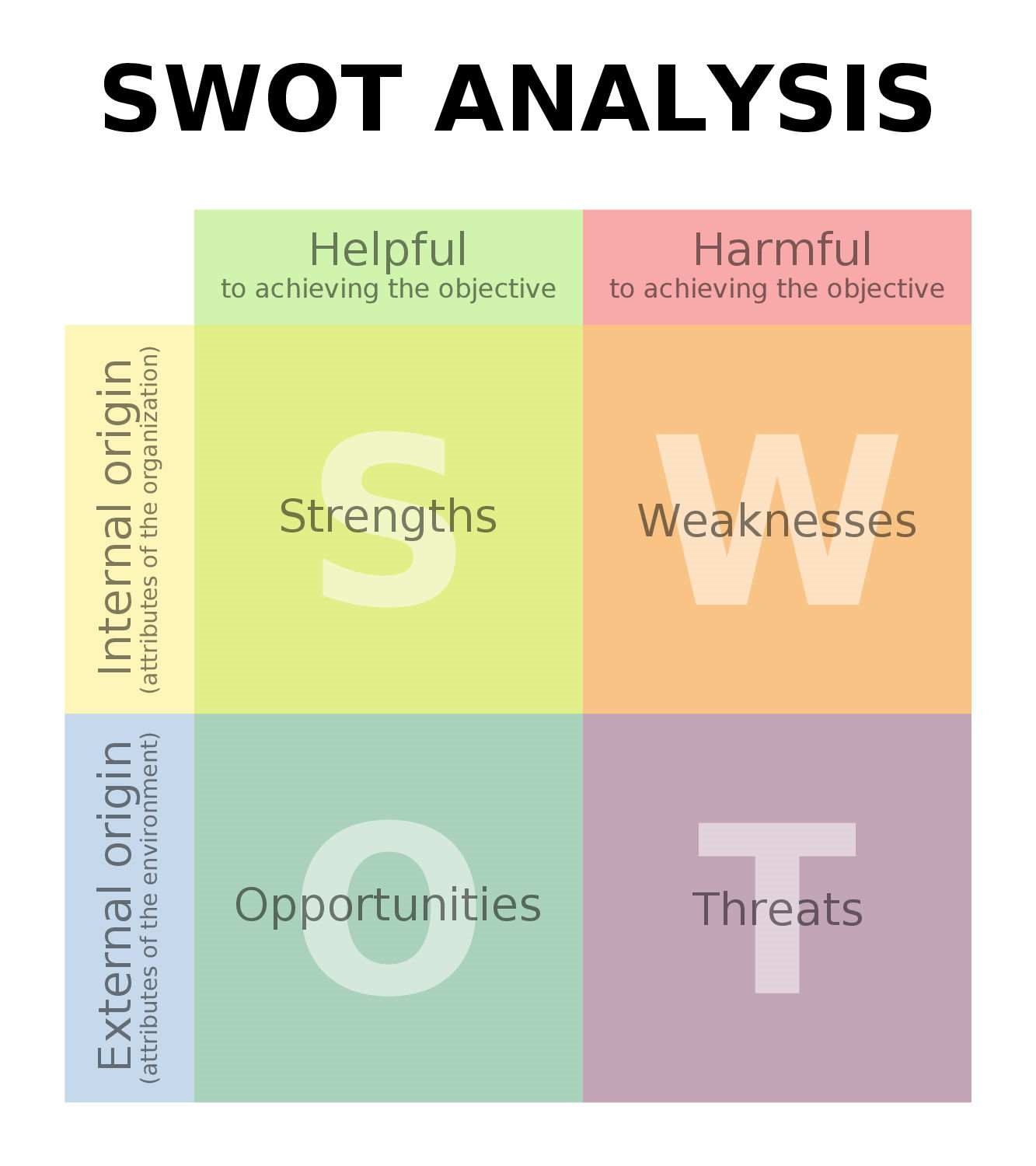
What is a SWOT analysis? SWOT is an acronym that stands for Strengths Weaknesses Opportunities and Threats.
Strengths and Weaknesses are internal factors that you can control while Opportunities and Threats are external factors that you cannot. You will also notice that Strengths and Opportunities represent positive or helpful factors while Weaknesses and Threats represent negative or harmful ones.
A SWOT analysis looks at a project or business venture by focusing on each of the four factors.
SWOT Analysis Factors
A SWOT diagram consists of four boxes- one for each factor. SWOT diagrams are useful when trying to decide whether or not to undertake a venture or strategy by visualizing the pros and cons. By outlining the positives and negatives of a project or venture, a SWOT analysis makes it easier to decide how to move forward.
Strengths
The first step is to figure out how to build on the strengths of your organization. A SWOT analysis is designed to help a business to identify the parts of the business that are doing well. Strengths are the business’s critical success aspects that are strong and give the business a competitive advantage in the market place. Being able to recognize these strengths helps the business to continue to focus and find ways to leverage and build upon these strengths to grow.
Some questions the business should ask about strengths are:
- What do customers identify as your strengths?
- What advantages do you have compared to your competitors?
- What does the business do really well?
- What assets and/or resources does the business have?
Weakness
The next step is to identify ways to improve on your weaknesses. Weaknesses are the factors that put you at a disadvantage compared to your direct competitors. Ascertaining the business’s weaknesses and taking action to reduce their effects on the business is the goal of the weakness block.
Some questions the business should ask about weaknesses are:
- What do customers criticize the business for not doing well?
- Where is the business most vulnerable and places it at a disadvantage, with respect to the competition?
- What complaints does the business receive?
- What should the business do better?
Opportunities
The next step in your SWOT analysis is to identify the opportunities available to the business. Opportunities are gaps in the industry or marketplace where the business operates and represent something that the business can fill. Opportunities represent external factors, such as market fluctuations and trends. When assessing opportunities, the business should consider its strengths and weaknesses. Not every opportunity has to be right for the business at the current time. Opportunities can be something that the business is working toward.
Some questions the business should ask about opportunities are:
- What are market gaps that we know about?
- What gaps does the business have the ability to address?
- Are there emerging industry trends?
- What trends can the business capitalize upon?
Threats
The last step in a SWOT analysis is to assess how the business will respond to potential threats. Threats are macro-environmental forces, such as market fluctuations, changes in public perceptions, government regulation, etc. Conducting a PESTEL analysis is helpful when assessing potential external threats that have the potential to negatively affect the business. The goal of the threat block is to ascertain the business’s threats and take actions to eliminate or reduce their effects on the business. As with opportunities, when assessing threats, the business should consider its strengths and weaknesses.
Some questions the business should ask about threats are:
- What are the emerging trends that have the potential to make us vulnerable?
- What PESTEL forces are likely to negatively affect our business?
- Do any of our weaknesses place us at a significant disadvantage compared to the competition?
- What gaps do we have in our business model that we have the ability to address?
Tips for Creating a SWOT Analysis
As a business conducts a SWOT analysis, it is common for some elements to be listed in more than one block as a reciprocal statement. For example, a “lack of presence in a market” could be stated as a weakness, and the reciprocal statement “become a presence in a market” could be stated as an opportunity.
- Keep the core objectives of the business in mind while performing your SWOT analysis.
- Keep the SWOT diagram brief. Include only the most pertinent details, and do not include too much explanation. Each bullet only represents a few keywords to remind the reader of talking points.
- If you have employees from different operational areas, be sure to get their input, as their observations may prove insightful.
- Get feedback from customers and partners as their feedback may also prove to be insightful.
- Order your bullet points in each block from most to least important so that it represents a priority of actions.
A SWOT analysis is not a static document, so consider updating the diagram on a regular basis such as quarterly, or at least annually.
Business & Finance Articles on Business 2 Community
(150)





